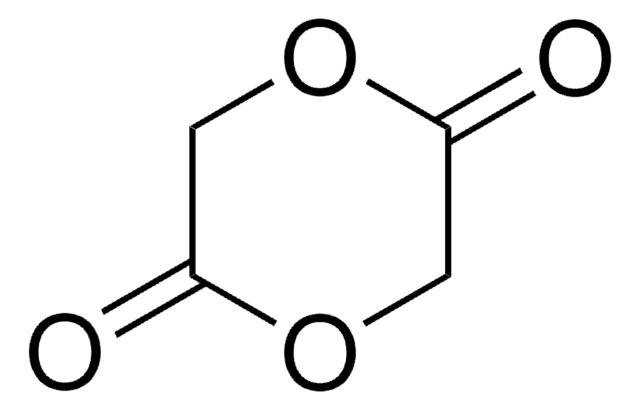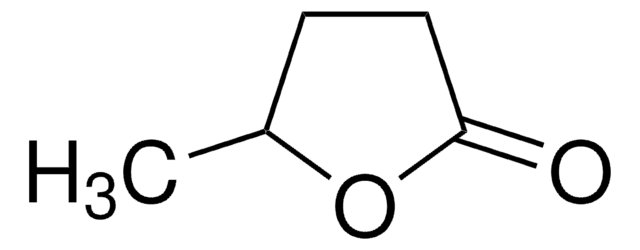704067
ε-Caprolactone
97%
Synonym(s):
2-Oxepanone, 6-Caprolactone monomer, 6-Hexanolactone
Sign Into View Organizational & Contract Pricing
All Photos(1)
About This Item
Empirical Formula (Hill Notation):
C6H10O2
CAS Number:
Molecular Weight:
114.14
Beilstein:
106919
EC Number:
MDL number:
UNSPSC Code:
12162002
PubChem Substance ID:
NACRES:
NA.23
Recommended Products
vapor density
3.9 (vs air)
Quality Level
vapor pressure
0.01 mmHg ( 20 °C)
Assay
97%
form
liquid
refractive index
n20/D 1.463 (lit.)
bp
97-98 °C/15 mmHg (lit.)
density
1.03 g/mL at 25 °C (lit.)
SMILES string
O=C1CCCCCO1
InChI
1S/C6H10O2/c7-6-4-2-1-3-5-8-6/h1-5H2
InChI key
PAPBSGBWRJIAAV-UHFFFAOYSA-N
Looking for similar products? Visit Product Comparison Guide
General description
ε-caprolactone is a cyclic ester. Ring opening polymerization of ε-caprolactone initiated by, tributylin n butoxide, ethyl magnesium bromide, or samarium acetate or heteropolyacid, leads to the formation of poly caprolactone (PCL).
Application
ε-caprolactone is popularly used in the preparation of poly caprolactone (PCL).
Signal Word
Warning
Hazard Statements
Precautionary Statements
Hazard Classifications
Eye Irrit. 2
Storage Class Code
10 - Combustible liquids
WGK
WGK 1
Flash Point(F)
228.2 °F - closed cup
Flash Point(C)
109 °C - closed cup
Personal Protective Equipment
dust mask type N95 (US), Eyeshields, Gloves
Choose from one of the most recent versions:
Already Own This Product?
Find documentation for the products that you have recently purchased in the Document Library.
Customers Also Viewed
Leonardus Kresna Widjaja et al.
Journal of the mechanical behavior of biomedical materials, 6, 80-88 (2012-02-04)
A series of triblock copolymers comprising end block of PLLA modified with PCL, and random copolymer of PCL and PTMC as soft segment were synthesized. DSC data show that PCL disrupted the crystallinity of PLLA, making the hard block to
Isabel Calejo et al.
Advanced healthcare materials, 8(15), e1900200-e1900200 (2019-06-14)
Tendon-to-bone interfaces exhibit a hierarchical multitissue transition. To replicate the progression from mineralized to nonmineralized tissue, a novel 3D fibrous scaffold is fabricated with spatial control over mineral distribution and cellular alignment. For this purpose, wet-spun continuous microfibers are produced
Lin Weng et al.
Advanced healthcare materials, 7(10), e1701415-e1701415 (2018-03-03)
An ideal synthetic bone graft is a combination of the porous and nanofibrous structure presented by natural bone tissue as well as osteoinductive biochemical factors such as bone morphogenetic protein 2 (BMP-2). In this work, ultralight 3D hybrid nanofiber aerogels
Sepideh Jalilzadeh-Tabrizi et al.
Biopreservation and biobanking, 16(2), 66-76 (2018-01-23)
Emu oil (EO) with anti-inflammatory, antioxidative, and wound healing properties can be blended for preparing bioactive nanofibrous scaffold. Adipose tissue-derived stem cells (ADSCs) are promising candidates for tissue engineering, and preserving their stemness potential is vital for further therapeutic applications.
Preparation of cellulose-graft-poly(ɛ-caprolactone) nanomicelles by homogeneous ROP in ionic liquid.
Yanzhu Guo et al.
Carbohydrate polymers, 92(1), 77-83 (2012-12-12)
Self-associating cellulose-graft-poly(ɛ-caprolactone) (cellulose-g-PCL) copolymers were successfully synthesized via homogeneous ring-opening polymerization (ROP) of ɛ-CL onto softwood dissolved pulp substrate in ionic liquid 1-N-butyl-3-methylimidazolium chloride ([Bmim]Cl). An organic catalyst N,N-dimethylamino-4-pyridine (DMAP) was compared with the traditional metal-based catalyst (Sn(Oct)(2)) as the
Our team of scientists has experience in all areas of research including Life Science, Material Science, Chemical Synthesis, Chromatography, Analytical and many others.
Contact Technical Service









